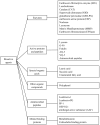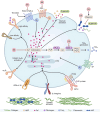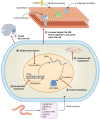Pharmacological effects of bioactive agents in earthworm extract: A comprehensive review
- PMID: 38957072
- PMCID: PMC11528390
- DOI: 10.1002/ame2.12465
Pharmacological effects of bioactive agents in earthworm extract: A comprehensive review
Abstract
This review compiles information from the literature on the chemical composition, pharmacological effects, and molecular mechanisms of earthworm extract (EE) and suggests possibilities for clinical translation of EE. We also consider future trends and concerns in this domain. We summarize the bioactive components of EE, including G-90, lysenin, lumbrokinase, antimicrobial peptides, earthworm serine protease (ESP), and polyphenols, and detail the antitumor, antithrombotic, antiviral, antibacterial, anti-inflammatory, analgesic, antioxidant, wound-healing, antifibrotic, and hypoglycemic activities and mechanisms of action of EE based on existing in vitro and in vivo studies. We further propose the potential of EE for clinical translation in anticancer and lipid-modifying therapies, and its promise as source of a novel agent for wound healing and resistance to antibiotic tolerance. The earthworm enzyme lumbrokinase embodies highly effective anticoagulant and thrombolytic properties and has the advantage of not causing bleeding phenomena due to hyperfibrinolysis. Its antifibrotic properties can reduce the excessive accumulation of extracellular matrix. The glycolipoprotein extract G-90 can effectively scavenge reactive oxygen groups and protect cellular tissues from oxidative damage. Earthworms have evolved a well-developed defense mechanism to fight against microbial infections, and the bioactive agents in EE have shown good antibacterial, fungal, and viral properties in in vitro and in vivo experiments and can alleviate inflammatory responses caused by infections, effectively reducing pain. Recent studies have also highlighted the role of EE in lowering blood glucose. EE shows high medicinal value and is expected to be a source of many bioactive compounds.
Keywords: antithrombotic; antitumor; bioactive agent; earthworm extract; pharmacological effects.
© 2024 The Author(s). Animal Models and Experimental Medicine published by John Wiley & Sons Australia, Ltd on behalf of The Chinese Association for Laboratory Animal Sciences.
Conflict of interest statement
The authors declare that they have no known competing financial interests or personal relationships that could have appeared to influence the work reported in this paper.
Figures





Similar articles
-
Enzyme promiscuity in earthworm serine protease: substrate versatility and therapeutic potential.Amino Acids. 2016 Apr;48(4):941-948. doi: 10.1007/s00726-015-2162-3. Epub 2016 Jan 7. Amino Acids. 2016. PMID: 26739820 Review.
-
The therapeutic effects of earthworm extract on deep second-degree burn wound healing.Ann Palliat Med. 2021 Mar;10(3):2869-2879. doi: 10.21037/apm-20-2393. Epub 2021 Feb 23. Ann Palliat Med. 2021. PMID: 33691441
-
From popular use to pharmacological validation: a study of the anti-inflammatory, anti-nociceptive and healing effects of Chenopodium ambrosioides extract.J Ethnopharmacol. 2013 Jan 9;145(1):127-38. doi: 10.1016/j.jep.2012.10.040. Epub 2012 Nov 1. J Ethnopharmacol. 2013. PMID: 23123797
-
The effect of earthworm extract on promoting skin wound healing.Biosci Rep. 2018 Apr 20;38(2):BSR20171366. doi: 10.1042/BSR20171366. Print 2018 Apr 26. Biosci Rep. 2018. PMID: 29531018 Free PMC article.
-
Medicinal Perspective of Antibacterial Bioactive Agents in Earthworms (Clitellata, Annelida): A Comprehensive Review.J Oleo Sci. 2022 Apr 1;71(4):563-573. doi: 10.5650/jos.ess21379. Epub 2022 Mar 14. J Oleo Sci. 2022. PMID: 35283417 Review.
Cited by
-
In vitro investigations of coelomic fluid of Eisenia fetida: protein analysis, antioxidant activities and antibacterial effects on diabetic wounds' bacteria.Iran J Microbiol. 2025 Feb;17(1):163-170. doi: 10.18502/ijm.v17i1.17814. Iran J Microbiol. 2025. PMID: 40330070 Free PMC article.
-
Liposomal Delivery of Allolobophora caliginosa Coelomic Fluid Attenuates Myocardial Infarction by Suppressing Oxidative Damage, Inflammation, and Apoptosis.Appl Biochem Biotechnol. 2025 Jul 16. doi: 10.1007/s12010-025-05340-y. Online ahead of print. Appl Biochem Biotechnol. 2025. PMID: 40668529
-
Combined use of anti-platelet aggregation drugs and shujin huoluo decoction for diabetic peripheral vascular disease: enhanced therapeutic efficacy.Am J Transl Res. 2025 Mar 15;17(3):1756-1767. doi: 10.62347/NFKV1920. eCollection 2025. Am J Transl Res. 2025. PMID: 40226037 Free PMC article.
-
Oxidative stress in cancer: from tumor and microenvironment remodeling to therapeutic frontiers.Mol Cancer. 2025 Aug 22;24(1):219. doi: 10.1186/s12943-025-02375-x. Mol Cancer. 2025. PMID: 40847302 Review.
-
Traditional Siddha Therapy Using Sivappu Kukkil Thailam (Topical) and Seendhil Chooranam (Oral) for Chronic Plaque Psoriasis: A Single-Patient Case Following the CAse REport (CARE) Guidelines.Cureus. 2025 Jul 11;17(7):e87732. doi: 10.7759/cureus.87732. eCollection 2025 Jul. Cureus. 2025. PMID: 40786349 Free PMC article.
References
-
- Xin T, Zhang Y, Pu X, Gao R, Xu Z, Song J. Trends in herbgenomics. Sci China Life Sci. 2019;62(3):288‐308. - PubMed
-
- Liu Z, Chen S, Cai J, et al. Traditional Chinese medicine syndrome‐related herbal prescriptions in treatment of malignant tumors. J Trad Chin Med. 2013;33(1):19‐26. - PubMed
-
- Fu Z, Zhang L, Liu X, et al. Comparative proteomic analysis of the sun‐ and freeze‐dried earthworm Eisenia fetida with differentially thrombolytic activities. J Proteome. 2013;83:1‐14. - PubMed
-
- Gu Y, Zhang J, Sun J, et al. Marker peptide screening and species‐specific authentication of Pheretima using proteomics. Anal Bioanal Chem. 2021;413(12):3167‐3176. - PubMed
Publication types
MeSH terms
Substances
Grants and funding
LinkOut - more resources
Full Text Sources
Other Literature Sources

